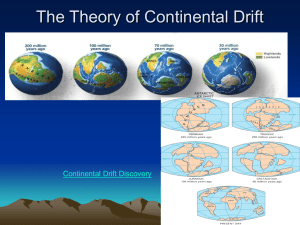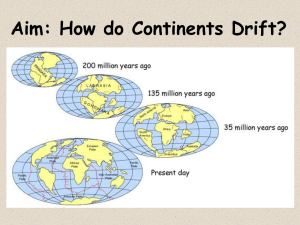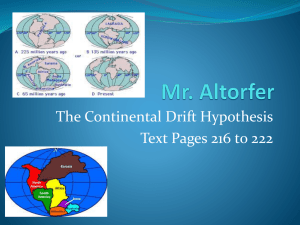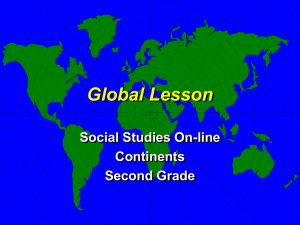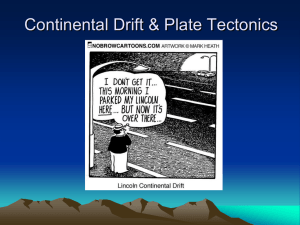Chapter 17: Plate Tectonics
advertisement
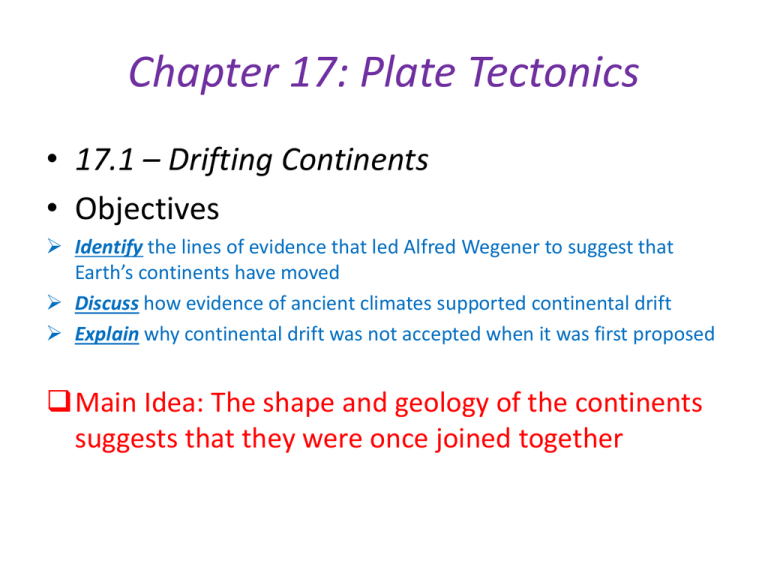
Chapter 17: Plate Tectonics • 17.1 – Drifting Continents • Objectives Identify the lines of evidence that led Alfred Wegener to suggest that Earth’s continents have moved Discuss how evidence of ancient climates supported continental drift Explain why continental drift was not accepted when it was first proposed Main Idea: The shape and geology of the continents suggests that they were once joined together Pre-conceptions • What does the phrase “plate tectonics” mean to you? • How about the phrase “continental drift”? Any different from “plate tectonics”? “It’s just a theory” • What is a scientific theory and what is it about a theory that makes it a good theory? Must be built upon evidence and hypotheses (reasoning & logical connections between the 2) Must be testable and held accountable during intense scrutiny (theories can be proven wrong by experiment or observation; wrong theories get modified, discarded, or replaced completely) No theory is ever proven Different from “laws” in that theories are a natural explanation of why a certain phenomenon happens while laws indicate what will happen Examples of common scientific theories: 1.) Gravitational theory 2.) Einstein’s theory of relativity 3.) Germ theory of disease 4.) Cell theory of organisms 5.) Valence theory of chemical compounds 6.) Theories of evolution in biology, geology, and astronomy Early Observations of Earth’s Geologic Past • Earth’s surface appeared to remain relatively unchanged during the course of a human lifetime With the exception of earthquakes, volcanic eruptions, and landslides • Early cartographers (those who study and practice making maps) in 1500s noticed the apparent fit of continents on either side of the Atlantic Ocean • Proposed that N. America & S. America had been separated from Europe and Africa by earthquakes and floods • First evidence of “jigsaw fit” from scientists like Francis Bacon (1620) • Frances Placet (1668) continents were actually fixed together and had been torn apart by the biblical flood 1915: The Origin of the Continents and Oceans • Alfred Wegener 1st time idea of moving continents was proposed as a real scientific hypothesis • Wegener’s Idea: Continental Drift Earth’s continents had once been joined in a single landmass, a supercontinent called Pangaea, that broke apart about 200 million years ago and sent continents adrift Wegener was 1st to base his ideas on more than just puzzle-like fit of continental coastlines….that was just the beginning Wegener collected and organized rock, climatic, and fossil data to support his hypothesis Wegener was a German scientists who was a well-known explorer and spent his profession in meteorology (study of the atmosphere) and astronomy Who is this wise guy? • At the time of Wegener’s hypothesis, there were 2 competing hypotheses about Earth’s ancient geography 1.) Biologists & Paleontologists suggested that Earth’s continents were once connected by land bridges that later sank beneath the oceans 2.) Geophysicists stated that isostatic principles made it impossible for land bridges to sink into oceanic crust Both groups firmly believed in the theory of permanence, that oceans basins and continents were permanent, unchanging features Wegener proposed that the biological & geophysical evidence would agree if Earth’s continents had changed positions over time Evidence From Rock Formations • Let’s see if you can reach Wegener’s conclusion regarding rocks IF there was this supercontinent, Pangaea, AND it broke apart, THEN….. Large geologic structures, such as mountain ranges, that fractured as the continents separated should show areas of similar rock types on opposite sides of the Atlantic Ocean Sure enough… Many layers of rocks in the Appalachian Mountains in the US were identical to layers of rocks in similar mountains in Greenland and Europe These similar groups of rocks, older than 200 million years, supported Wegener’s idea So far….so good Similar Rock Types Evidence From Fossils • How do you think fossils would help Wegener’s idea? Similar fossils of animals & plants that once lived on or near land had been found on widely separated continents Animals such as Cynognathus and Lystrasourus could not have swum the great distances that now exist between In addition, fossils from Mesosaurus, an aquatic reptile, had been found only in freshwater rocks; therefore it was unlikely that this species could have crossed the oceans Ages of these fossils also predated Wegener’s time frame for the breakup of Pangaea…..supporting his hypothesis Climatic Evidence • Wegener’s strong background in meteorology helped him recognize clues about ancient climates from fossils he studied Fossils of the plant Glossopteris had been found on many parts of the Earth, including South America, Antarctica, and India Wegener reasoned that the area separating these fossils was too large to have had a single climate In addition, he knew that because Glossopteris grew in temperate climates, the places where these fossils had been found were once closer to the equator How did coal end up in Antarctica? • Coal forms from the compaction and decomposition of accumulations of ancient swamp plants • Wegener used the existence of coal beds in Antarctica to conclude that Antarctica must have been much closer to the equator at some point There was ice where??? • Glacial deposits nearly 300 million years old were on several continents • Because the traces of the ancient ice caps were found in regions where it is too warm (Africa, India, Australia, and S. America), Wegener proposed that they were once located near the South Pole Wegener suggested 2 possibilities for this: 1.) Earth’s axis changed so that the south pole had shifted its position 2.) These landmasses had once been closer to the south pole The 2nd suggestion seemed much more likely Sorry Buddy….. A rejected notion: Although Wegener had compiled an impressive collection of data, the hypothesis of continental drift was never accepted by the scientific community mainly because of 2 unanswered questions: 1.) What forces could cause the movement? Wegener thought that the rotation of the Earth might be responsible until physicists came along and ruled that out…. 2.) How could continents move through solids? Wegener had suggested that continents were plowing through a stationary ocean floor, but it was known that Earth’s mantle below the crust was solid Though there were other reasons, these 2 questions were the main reasons why Wegener’s theory of continental drift was rejected So why did I just tell you all this stuff if it wasn’t accepted??? • Good things come with time ;) Wasn’t until the 1960s when new technology revealed more evidence about how continents move that scientists began to reconsider Wegener’s ideas Advances in sea floor mapping and in understanding Earth’s magnetic field provided the necessary evidence to show how continents move, and the source of the forces involved….as we will see later!
